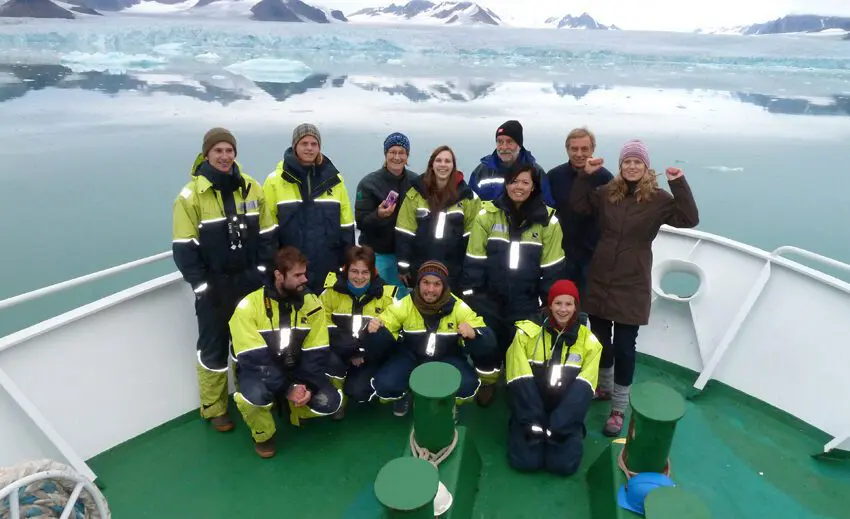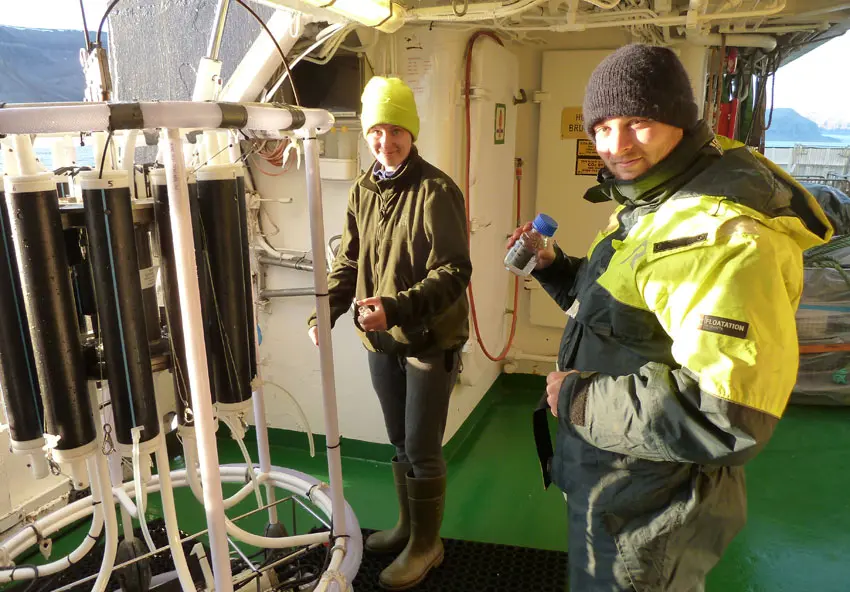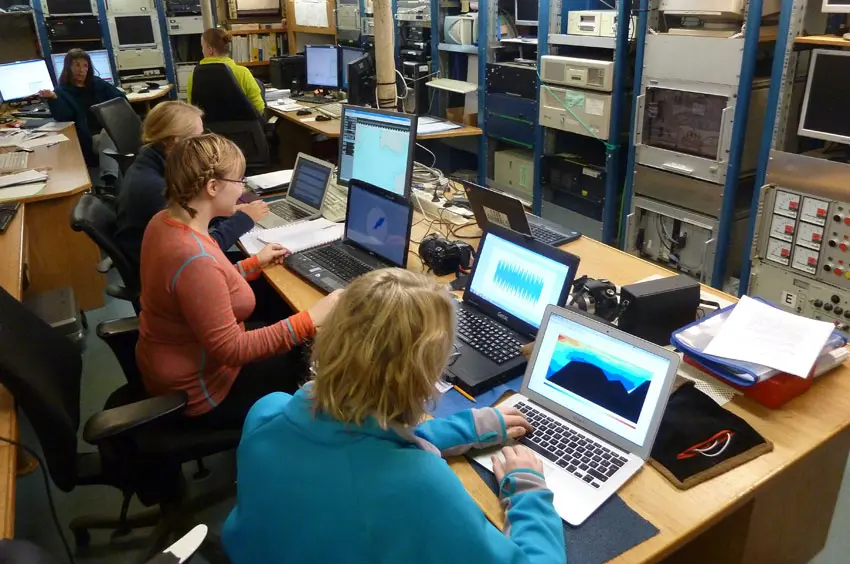AGF-214 Polar Ocean Climate (15 ECTS)
ID:
AGF-214
CREDITS:
15 ECTS
APPLICATION DEADLINE:
March 01, 2025
START DATE:
August 11, 2025
END DATE:
December 12, 2025
COURSE PERIOD:
Autumn semester. Teaching block 5-7

The AGF-214 course cruise in Krossfjorden. Photo: Ragnheid Skogseth/UNIS.
| Grade: | Letter grade (A through F) |
| Course Cost: | Fieldwork, NOK 1400 (7 days x NOK 200 per overnight stay) |
| Course Capacity Min/Max: | 9/18 students |
| Language of instruction: | English |
| Examination support material: | Bilingual dictionary between English and mother tongue |
Course requirements
60 ECTS in mathematics and physics or a related discipline. 20 of these ECTS can be fulfilled by courses in disciplines closely related to mathematics and physics, such as meteorology, oceanography, climate dynamics, geophysics, or data science.
The applicant must be enrolled in a programme at Bachelor level, or document that the courses are approved into the applicant’s current study programme.
It is also recommended that students have a minimum basic knowledge of oceanography corresponding to Chapter 1-6, 8, 9.11 in Pond and Pickard (1983): “Introduction to Dynamical Oceanography”, Pergamon Press, or to similar texts.
It is an advantage to have basic knowledge in thermodynamics, mechanics, partial differential equations, and experience in data analysis using for example Matlab or Python.
The course should be combined with AGF-213 Polar Meteorology and Climate, and the courses are designed to complement each other.
Academic content
The course offers an introduction and overview of the water masses and current systems in the Arctic Basin, the Greenland, Norwegian, and Barents Seas, and a comparison with the Southern Ocean around Antarctica. The seasonal change in surface forcing from cooling and freezing of surface water in autumn and winter heating from sun radiation and to fresh water input from sea ice-, snow-, and glacier melt in spring and summer are associated with water column stratification and convection influencing the vertical structure of the water masses. The thermobaric effect on the compressibility of seawater has its relevance for determining the deep circulation in the world’s oceans. The small-scale double diffusion also has an impact on convection in regions where the conditions for this process are favorable. The dynamic theory is associated with the circulation and current systems in the different Polar Regions, in particular the Arctic Basin, the Greenland Sea, and the circulation around Antarctica. Essential processes here are the wind-induced circulation, including rotational effects, upwelling and downwelling associated with wind-induced divergence and convergence, and tidal currents. Frontal dynamics and the topographic impact on current systems are also covered. Topics will be discussed in relation to climate history, current physical conditions, and future climate change.
Learning outcomes
Upon completing the course, the students can:
Knowledge
- describe the different water masses and the currents found in high latitude regions, and explain physical and dynamical processes in the Polar Oceans (Arctic and Antarctic)
- understand and demonstrate how these processes influence the property distribution in Arctic fjords
- explain the influence of sea ice on the water masses below
- understand basic tidal theory, how tides influence sea level and circulation of water, and describe tides around Svalbard.
- recognise the role of the Polar Oceans in shaping the global climate.
Skills
- show practical skills in basic field and laboratory methods on scientific cruises, like handling scientific instruments as CTD, L-ADCP, VM-ADCP, and moored instruments used in physical oceanography, and collect and perform analyses of water samples for different water parameters
- process and analyse the scientific data collected during the cruise using the computer-based and data handling software MATLAB or Python
- conduct small field projects on a scientific cruise.
General competences
- efficiently administrate workload and share information within a group
- produce and review scientific reports based on data collected during field work
- relate their own field observations to knowledge achieved through lectures and literature in polar ocean climate
- communicate scientific results, both in writing and orally, from field reports and relate them to previous studies
- critically read, evaluate, and debate scientific literature.
Learning activities
The course extends over a full semester. Initially, students attend four days of compulsory Arctic survival and safety training.
A weeklong scientific field cruise is a central learning activity in AGF-214. The field cruise provides first-hand experience of the Arctic environment at sea, and enables a deeper understanding of the complex interplay of exchanges between atmosphere, cryosphere, land, open ocean and fjords affecting the polar ocean climate. Before and during the field cruise, students will work in groups to get and provide an overview of oceanographic instruments used onboard and on moorings, how they work, how to operate them, and the quality and nature of the data collected. Students work in day and night shifts alongside with the crew and the teaching staff on a research vessel, which give them the opportunity to learn hands-on how oceanographic data are collected, processed, and analysed.
Research projects are another important learning activity in AGF-214, and are closely linked to the field cruise. During the first week, students choose a small research project under guidance. Through the project work the students are introduced to field-based research methodology, and the process of collecting, analysing, evaluating, and communicating scientific results. During the cruise, the students practice various sampling techniques when collecting data for their own and their fellow students’ research projects. After the field cruise, we spend time with MATLAB and Python both individually and in work-shops, analysing and presenting collected data. During the semester, parallel with other learning activities, the students work with analyses and interpretations of their data through supervision and through providing and receiving compulsory fellow student reviews on assignments, and finally deliver a written report and present their results orally.
Through classroom lectures, seminars, exercises, and literature review the students are given a good understanding of physical oceanography in high latitudes. Besides lectures, we also utilize learning activities such as student driven seminars, group work, and literature discussions to achieve deeper content knowledge, and provide students with competence to read, evaluate, and debate scientific literature.
The final assessment will test the students in their understanding of the theory and how they have implemented it in their reports.
Summary
- Total lecture hours: 65 hours.
- Total seminar hours: 20 hours.
- Field exercises: 7 days.
Compulsory learning activities
All compulsory learning activities must be approved in order to sit the exam.
- Fieldwork with accompanying workshops
- Fellow student reviews on field report
- Oral presentation of report
Assessment
- Each assessment is graded, and subsequently combined into a single grade. Partial grades for each assessment will be available.
| Method |
Percentage of final grade
|
| Field report | 30% |
| Oral exam | 70% |
Student life


